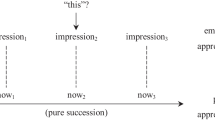Abstract
The doctrine of radical impermanence (kṣaṇabhaṅga) expresses the temporal dimension of Buddhist metaphysics, especially in the philosophy of Dharmakīrti and his successors. Most straightforwardly, the doctrine says that everything that exists is momentary; we are not impermanent (anitya) in the sense that we perish eventually, say when our brain ceases functioning, but rather we perish immediately upon conception. The person who begins to write this sentence and the person who completes it are, strictly speaking, different entities. However, there is a devastating problem for the doctrine: How can any momentary entities be causally efficacious (arthakriyā), and more particularly, given their extremely meager duration of existence, how might the momentarist explain the phenomena of cooperation among contemporaneous entities to occasion novel entities, such as seeds, soil, water and sunlight giving rise to sprouts? Even more difficult, can the momentarist offer such an explanation that does not undermine his negative claim that non-momentary things cannot exist? Śāntarakṣita (eighth century) and Ratnakīrti (eleventh century) offer answers, but they both fail. By meticulously analyzing and evaluating their arguments, I identify the stumbling blocks of their arguments and show what needs to be done to save the doctrine of momentariness.
Similar content being viewed by others
References
Primary Sources
Ratnakīrtinibandhāvaliḥ. Anantalal Thakur, ed. Patna: Kashi Prasad Jayaswal Research Institute, 2nd ed., 1975.
Tattvasaṅgraha of Acārya Shāntarakṣita with the Commentary ‘Panjikā’ of Shri Kamalashīla, Vol. 1. Swami Dwarkadas Shastri, ed. Varanasi: Bauddha Bharati, 1968.
Secondary Sources
Chatterjee, K. N. (1988). Tattvasaṅgraha (Sthirabhāvaparīkṣā). Calcutta: Vijaya-Veeṇa.
Feldman, J., & Phillips, S. (2012). Ratnakirti’s Proof of Momentariness by Positive Correlation (Ksanabhangasiddhi Anvayatmika). New York: Columbia University Press.
Haslanger, S. (2003). Persistence through time. In M. J. Loux & D. W. Zimmerman (Eds.), The Oxford handbook of metaphysics. Oxford: Oxford University Press.
Jha, G. (1986). The Tattvasaṅgraha of Shāntarakṣita with the commentary of Kamalashīla (Vol. I). Delhi: Motilal Banarsidass.
Lowe, E. J. (2002). A survey of metaphysics. Oxford: Oxford University Press.
McDermott, A. C. S. (1969). An eleventh-century Buddhist logic of ‘Exists’. Dordrecht: D. Reidel.
Mookerjee, S. (1935). The Buddhist philosophy of universal flux. Delhi: Motilal Banarsidass (First published 1935, sixth edition 2006).
Rodoriguez-Pereya, G. (2009). Leibniz: Mind–body causation and pre-established harmony. In R. Le Poidevin, P. Simons, A. McGonigal, & R. P. Cameron (Eds.), The Routledge companion to metaphysics. London: Routledge.
Sharma, C. (1960/2003) A critical survey of Indian Philosophy. Delhi: Shri Jainendera Press.
Woo, J. (1999). The “Ksanabhaṅgasiddhi-Anvayatmika”: An Eleventh-Century Buddhist work on Existence and Causal Theory. Unpublished PhD Dissertation, University of Pennsylvania.
Yoshimizu, C. (1999). The development of Sattvānumāna from the refutation of a permanent existent in the Sautrāntika tradition. Wiener Zeitschrift für die Kunde Südasiens, 43, 231–254.
Author information
Authors and Affiliations
Corresponding author
Rights and permissions
About this article
Cite this article
Hayashi, I. Can Flux Bring About Flux? An Appraisal of the Buddhist Momentarist’s Response to the Causal Objection. J Indian Philos 45, 49–71 (2017). https://doi.org/10.1007/s10781-016-9298-7
Published:
Issue Date:
DOI: https://doi.org/10.1007/s10781-016-9298-7




